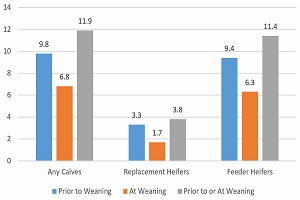
According the 2007-2008 USDA Reference of Beef Cow-calf Management Practices in the United States, approximately two-thirds of cattle operations (60.7%) used an auction market as the primary method of sale for weaned steers & bulls. These auction markets are a cornerstone of the American cattle industry, so it makes sense to utilize the owners or managers as a resource to help you increase the profitability of your operation.
Ed Neel is the owner/operator of Dothan Livestock Market in Dothan, AL. Every morning Neel can be found at the market, and on Monday mornings he is on the auction block, selling calves (Image 1). Running a livestock market is nothing new to Neel, he has been working in the livestock marketing industry since the 1970’s. Through a recent interview with Neel, he shared his ideas on some basic management practices that cow-calf producers should be utilizing to improve the demand for their calves, and ultimately the total value their calves sold at an auction market.
Castrate Bull Calves
Neel said that, “Buyers will pay a premium for castrated calves. For 400 weight calves you will generally see a $0.10/lbs to $0.15/lbs in calves that have been castrated.” Taking this into consideration producers are leaving $40.00 to $60.00 per head on the table by failing to castrate their bull calves.
Regional and operation size differences have been documented in regards to castration practices in cow-calf operations. Smaller operations are less likely to castrate their calves than larger operations. Only 50.3% of operations with fewer than 50 head head castrate bull calves, while 85.1% of herds with 100 or more head castrated their calves prior to marketing them. In addition, only 43.9% of producers in the South castrate bull calves, compared to 92.3% are in the Western states (USDA, 2007).
Commonly the thought is that castration of bull calves will result in reduced gains prior to weaning. A University of Florida study (1) used Brangus calves to examine if age of castration would alter the overall 205 day weaning weight of calves. Calves were castrated at either 36 days of age (early) or at 131 days of age (late). This research found that there was no difference in pre-weaning gains when calves were castrated at either 36 days or 131 days of age.
Research conducted at Oklahoma State (2) shows that castration after arriving at the feed yard can result in a 19% decrease in ADG (average daily gain) when compared to bull calves. In addition, steers had an increased ADG of 0.58 lbs over cut bulls during the initial feeding phases. This decrease in ADG and feed intake, in addition to increase health and morbidity risk, all contribute to the buyer’s ability to pay a premium for castrated calves.
Genetics and Management
At the end of the day, quality will always be rewarded. Calves with good growth potential, that show quality genetics through confirmation and phenotype will continue to bring demanded in the market place. Neel believes, “If you bring good quality calves to the market, buyers will pay for them.”
Sire selection becomes key in making genetic improvements to your herd. Each cow has the ability to genetically influence only one calf per year, however, a herd sire has the opportunity to influence 25 to 30 calves annually (in natural breeding system). Making breeding decisions that lead to genetically superior calves with strong performance characteristics is key in having a successful day at the livestock market.
In addition, buyers can tell if calves come from an operation with good management practices. “Calves need at least one round of shots, two is best” said Neel, “and when a calf comes in that is dehorned, castrated, and has a tag in its ear, you can tell they come from an operation with good management practices.” These good management practices will pay off. According to Neel you will typically see a $0.10/lbs increase at the livestock auction.
Implant Your Calves
“Buyers DO NOT discount for implanted calves, in fact, most of the time they don’t know whether or not the calves have been implanted when they come through the market ring,” said Neel. So why do only 9.8% of cattle producers in the U.S. implant their calves? (Figure 1)

Since being approved for use in beef calves in the 1950’s, growth implants have shown consistent increases in the average daily gain (ADG) of suckling calves. A review of research on implanting calves by Dr. Selk, Oklahoma State University (4) shows that an increased ADG of 0.10 lb/day in steers and 0.12 to 0.14 lb/day in heifers when implants are properly administered. Implants are most effective when calves from 60 to 180 days of age. This date would support that an average weight gain of 12 pounds pre-weaning would result from implanting a steer calf in your herd.
Growth implants for calves cost around $1.00 per head plus labor. This week at the Dothan Livestock Market, Medium to Large, 1 & 2 450 lbs steers brought up to $1.49 Therefore, 12 pounds of addition gain, with $1.00 of expense, would result in a tremendous return on investment of $17.88 per head. There are few tools that beef producers can invest $1.00 in that provide such an excellent return.
While some producers will say they have implanted their calves and did not notice a difference, a 12 pound difference in overall weaning weights could be difficult to visibly notice, even to the most experience cattle producers, however, the additional $17.88 per head would be easy to notice in the market check.
As bull sale season draws near, producers need to keep in mind that investing in superior genetics will pay dividends when calves are marketed. In addition, implementing basic management strategies, such as castrations, dehorning, vaccinations, and utilization of growth implants will add to the total value of calves sold at your local market.
Source: ufl.edu